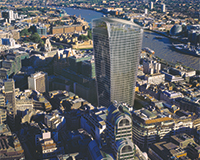 There was palpable glee this week when the Walkie Talkie, EC3, was awarded the Carbuncle Cup and named the UK’s worst new building. It’s a misleading accolade for perhaps the most successful development of recent years.
There was palpable glee this week when the Walkie Talkie, EC3, was awarded the Carbuncle Cup and named the UK’s worst new building. It’s a misleading accolade for perhaps the most successful development of recent years.
The award, made by Building Design magazine, is always much anticipated. It talks directly to its core audience: architects, who are bound to believe they could have done a better job. (Indeed, many of the nominees are also RIBA Award-winners). And it taps into the wider public consciousness too: everyone has a view on a prominent building’s aesthetics.
Put simply – and I say this with grudging admiration – the cup is the X Factor of the development world. And just as the X Factor did, the Carbuncle Cup captures the zeitgeist. Here too, visceral, instinctive reaction often counts for more than fundamentals and rigorous analysis.
It also, of course, captures the virulent anti-development feeling so prevalent today, especially in London.
But what it neglects is that the award has gone to a building that in terms of density makes more of its footprint than any other, that is loved by tenants and was 87% let ahead of completion.
None of that makes it the most attractive building, of course, though on Twitter this week there were plenty of architects (and others) who endorsed the design.
A quick Estates Gazette poll showed wider support: 62% of voters said it did not deserve to be named the UK’s worst new building.
One Twitter user captured the sentiment: “Why no consideration of occupier opinion? Buildings are not just there to be looked at. Clearly architectural integrity is important, but buildings are there to house people to live, work and play. When making a qualitative assessment, we should go beyond aesthetics.”
Quite. The Carbuncle Cup may be about aesthetics but the wider debate about development – “any new tall building seems to get it in the neck” ran another tweet – has to be broader.
Berkeley Group bounced back into the FTSE 100 this week; its share price up 36% since the start of the year.
It is always dangerous to proffer reasons for such sharp movements, but there are clear factors that you might expect to count against the company’s ascent.
A 36% increase in share price is an outstanding performance over a period when the FTSE 100 has fallen by 7%. And for a housebuilder delivering some 10% of all new homes in London to perform so well when tax and regulatory changes, currency movements and global instability are seen as counting against the capital is impressive.
It of course has everything to do with the fact that Berkeley is as shrewdly run as they come; that London will continue to be a draw; and that the firm is committed to returning cash to shareholders, with £123m – or 90p a share – slated for a fortnight’s time. And more to follow.
It is also worth noting that Berkeley’s return to the main index means that, with four housebuilders and four REITs in the FTSE 100, property now accounts for – and you are probably ahead of me here – 8% of the lead indicator of UK plc’s financial health.
A new logo, a new leadership team and a new name for half the business. Cushman & Wakefield was reborn this week and the DTZ brand in all key markets consigned to the dustbin of history. The team at the top is a strong one, the name a done deal (so no point mourning) and the new brand confident and classy.
There is an inevitable and perhaps ominous corporate video on YouTube too. Fast cuts, dramatic music and familiar faces – with Carlo Barel di Sant’Albano and John Forrester in blink-and-you-miss-them cameos.
There is a message for rivals too in the text that flashes on screen late on: “one of the largest firms… and that’s just day one”.










